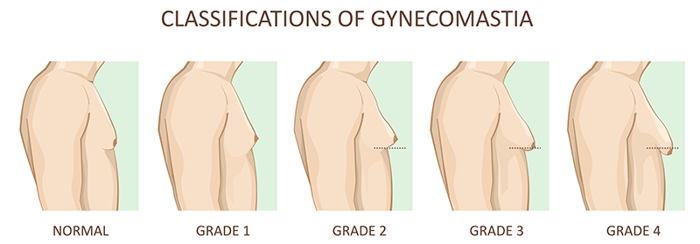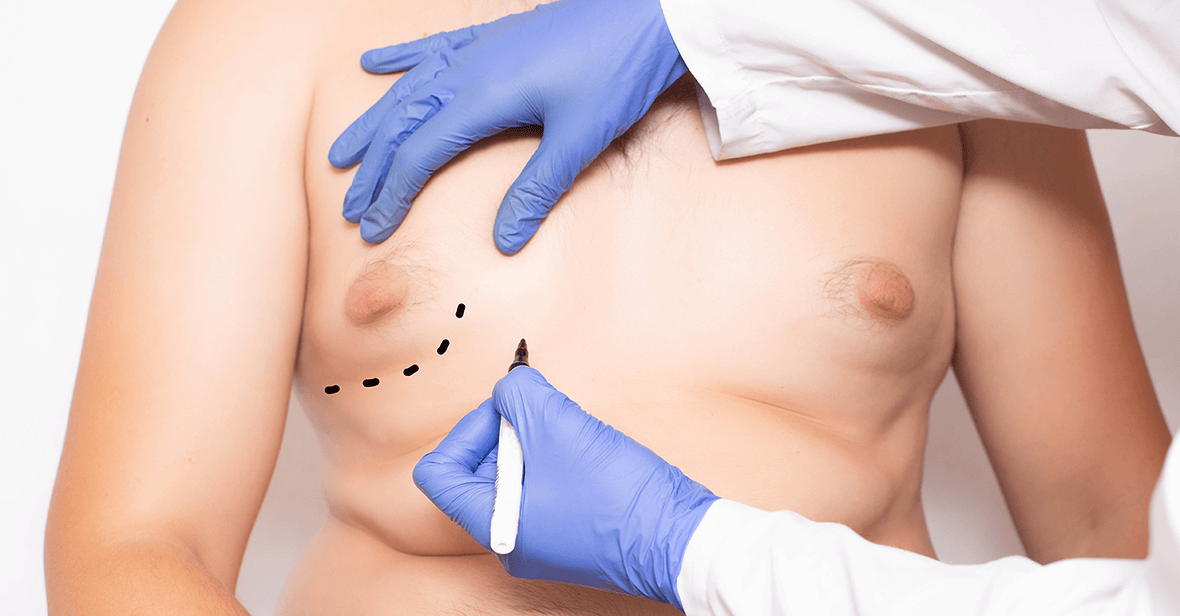Aesthetic Procedures: Gynecomastia-surgery
Gynecomastia Surgery
What is gynecomastia?
Gynaecomastia, commonly termed and “Man/Male Boobs” or “Male Breasts”, is a common and distressing condition in male patients and is defined as the presence of abnormal enlargement of breast tissue in the male chest. This excessive male breast tissue development can have an incidence of up to 32 to 65 percent in the male population. (1) It can sometimes be part of normal physiology in the newborn, pubescent, and elderly populations. Sixty percent of boys develop this transiently, and it can be present in 30% to 70% of adults.
There are usually 3 age groups in idiopathic gynecomastia which correspond to times of physiologic hormonal change. These are the neonatal, pubertal, and older (> 50years old) age groups.
Work-up of gynecomastia first involves a thorough history and examination to uncover any sinister underlying causes. These may be followed by ultrasound scans of the breasts or testes as well as blood tests. Once any treatable medical conditions have been excluded, gynecomastia surgery for breast reduction can be considered.
Why do I suffer from gynecomastia? What are the common causes?
There are numerous identifiable causes of gynaecomastia, though most cases are often idiopathic (no identifiable cause). Some of the identifiable causes include developmental and drug-induced causes, endocrine, metabolic or hormonal imbalances, tumors, systemic illnesses, congenital disorders, and familial, idiopathic, and miscellaneous causes.
In addition, patients with high BMI or high body fat percentage may also find an increased accumulation of fatty deposits around the chest area, which may accentuate the appearance of gynaecomastia. This condition is also commonly termed as pseudogynaecomastia.
A comprehensive clinical evaluation consisting of detailed history taking and physical examination would be recommended to exclude identifiable cause(s) of gynaecomastia.
This table provides some of the identifiable causes of gynaecomastia. (REF 3)
|
Causes |
Examples |
|
Medications |
Сertain medications used to treat conditions such as prostate enlargement, anxiety, depression, heart failure, gastritis, male infertility and HIV, illicit drug or alcohol use |
|
Hormonal changes |
Infants, puberty, age-related hormonal changes |
|
Health conditions |
Hypogonadism, endocrine tumors (pituitary/adrenal tumors), liver failure/cirrhosis, kidney failure, thyroid disease, increased BMI (with high peripheral estrogen production) |
|
Herbal/ supplement products |
Certain products containing ingredients with estrogenic activity have been associated with the condition |

Can Gynecomastia be prevented?
By controlling certain risk factors for gynaecomastia, such as avoiding alcohol and drugs which may cause it, one may reduce the risk of gynaecomastia. On top of that, losing weight and exercising helps reduce subcutaneous fat and build up better musculature in the male chest, improving the overall appearance.
Is it possible to improve the contour of my chest (Pectoralis Major) muscle to look more masculine?
Yes absolutely! On top of liposuction removal of unwanted breast tissue, enhancements can be made by grafting fat into/onto areas of the chest muscle which require more volume. This procedure is not suitable for everyone, and it has to be tailored to each individual’s aesthetic goals of surgery.
How is gynecomastia surgery performed?
There are many different grading systems for gynecomastia, most involving the assessment of skin versus excess breast tissue. Treatment modalities are then aimed at removing these two aspects.
Excess breast tissue can be removed through a combination of liposuction and excision of the fibrous breast disc behind the nipple by using a small incision around the areola. If there is excess skin, there may be a need to remove skin in a mastopexy-style approach using a periareolar or vertical scar, depending on the amount. More recently, ultrasound-assisted liposuction (VASERTM) has been used to good effect in both removing breast tissue, and thermal tightening of skin without having to make large incisions. This is suitable for patients with mild to moderate excess skin and smaller fibrous breast discs.
The aim of gynecomastia surgery should be to give the patient a shapely, athletic male chest suitable for their body type. It goes beyond just pure removal of tissue. At Polaris Plastic & Reconstructive Surgery, our doctors utilize both VASERTM and other techniques to give you an outcome tailor-made to your goals and desires.

How would I know if I need surgery for Gynecomastia?
Some signs and symptoms of gynaecomastia include:
1) Pain, and tenderness on pressing or palpating the swollen tissue
2) Swollen breast tissues
3) Nipple sensitivity, pain, abrasions or discharge
More commonly, patients feel conscious about the feminine appearance of their chest, and may avoid certain type of clothing or activities that may make their “man boobs” more obvious. This impacts negatively on their self-confidence, and affect their psycho-social wellbeing.
Restoring the ideal male chest – the goal of surgery is to restore the appearance of masculine male chest, which typically exhibits superior fullness with a transition to a flat inferior chest near the inframammary fold. The nipple-areolar complex should also be sited at an ideal location on the chest, to create a harmonious appearance for the entire torso.
Not only does gynaecomastia surgery aim to relieve the symptoms suffered, it also helps to restore masculinity to the male chest and improve one’s self-confidence.
What should I expect if I were to be going for a gynecomastia Procedure? What happens during the surgery?
Modern techniques of gynaecomastia surgery often involve minimally invasive techniques to remove gynaecomastia tissue. This usually involves liposuction techniques to remove most of the tissue through tiny holes in the skin. Well-hidden small incisions may sometimes be employed to remove the residual fibrous breast tissue after liposuction.
In more severe cases of gynaecomastia, where there is displacement of the nipple-areolar complex and large amount of excess skin, larger incisions could be used to further contour the chest area to give a more pleasing aesthetic of the chest.
It is also commonplace for additional procedures to be performed together with gynaecomastia surgery, to further enhance the surgical results. Such procedures include fat grafting to enhance muscular contours, liposuction of the arms, flanks and abdomen to improve the entire torso.
Operative Details
Pre-operative preparation: Our team would provide you with the necessary pre-operative instructions and preparatory steps before surgery. For example, cigarette / e-cigarette smoking would have to be strictly stopped for (at least) 1 month before and after surgery, as this severely impairs wound healing and recovery, and significantly increases rate of complications. We would encourage you to maintain your good diet and exercise regime, and set up a safe space at home or home recovery area to optimise your healing.
Operative phase: On the day of surgery, you and your plastic surgeon will mark out and discuss the areas which are to be addressed during surgery. Gynaecomastia surgery is typically 1-2 hours in duration, performed as a day surgery procedure, and patients are allowed to rest at home on the same day.
What can I expect after gynecomastia surgery?
There are usually no stitches to be removed. Pain is usually well controlled with oral painkillers, and you can perform most daily activities on your own the day after surgery. You should avoid exercise for 3 to 4 weeks after surgery to aid with healing. The final result after skin retraction and reduction in swelling is seen at 2 to 3 months after surgery.
What is the downtime/recovery period for Gynaecomastia Surgery?
Wounds would typically take 1-2 weeks to heal, and you will be able to expose these scars once they have healed. We would typically advise for you to keep to simple daily activities during this healing phase. Some pain maybe felt after surgery, but this would be optimised with painkillers and typically subside within the first week or so; it is normal to feel “tight” thereafter. You may resume light desk-bound work and daily commute with your compression garments as soon as you feel comfortable within the first few days.
From thereon, you may be able to resume light exercise from 3 weeks onward, based on your own comfort level. It is best to avoid heavy lifting for at least 6 weeks, to allow internal healing to take place without disruption. More intensive exercises can be resumed as early as 2-3 months after surgery, and we would be at hand to advise you on this during your follow-up consultations. It is recommended that the compression garments to be worn for about 6 weeks, and gradually weaned off thereafter.
What are the potential complications of gynecomastia surgery?
How much does Gynaecomastia Surgery cost? Can this be covered by insurance in Singapore?
Suffering from gynaecomastia can be symptomatic and debilitating, therefore medical treatment of this condition can often be covered by insurance. Speak to your Plastic Surgeon to find out if your gynaecomastia procedure can be covered by insurance.
FAQs
Is gynecomastia surgery covered by my insurance?
As gynecomastia is an abnormal accumulation of breast tissue in a male, your breast tissue from the procedure will routinely be sent for testing to determine whether there are any sinister abnormalities. However, insurance coverage for gynecomastia surgery is variable according to the insurance company. Our doctor will work with you on communication with your insurance company to see if this is possible, though insurance coverage cannot be guaranteed.
2. Holzmer SW, Lewis PG, Landau MJ, Hill ME. Surgical Management of Gynecomastia: A Comprehensive Review of the Literature. Plastic Reconstr Surg Global Open. 2020;8(10):e3161.
PATIENT STORIES
Post Massive Weight Loss Body Contouring
A 40-year-old lady consulted with Dr Pek with the desire to correct large amounts of excess skin and soft tissue. She had undergone Bariatric Surgery (Sleeve Gastrectomy) 2 years prior to her presentation and had successfully lost almost 30kg of weight. With ... Read more
Treating Gynecomastia – Correct Male Breasts through minimally invasive techniques
A 38-year-old male engineer presented to Dr Pek with symptomatic growth of his chest/breast area. Since puberty, he complained of unusually prominent chest tissue around his nipple and areolar region. This had worsened gradually over the years, with the left ... Read more
Upper eyelid lift and eyebags rejuvenation
63 years old Chinese female with hypertension and hyperlipidemia presented to Dr Pek with significant droopiness of her upper eyelids on both sides, affecting the upper portion of her visual field. She would constantly feel that her upper eyelids were heavy, ... Read more
Bilateral breast reconstruction using abdominal free flaps
A 45-year-old mother of 2 children was diagnosed with left breast cancer, for which a skin-sparing mastectomy (total removal of breast tissue leaving behind the skin envelope) was recommended. Read more
ARTICLES
Let's be real, we all have those areas of our body where ...
Rhinoplasty, commonly known as a nose job, is a surgical ...
Plastic reconstructive surgery is a specialised field that ...
Droopy eyelids are not just a cosmetic concern. While it ...
Contact Form
1 Orchard Boulevard #10-08 Camden Medical Centre, Singapore 248649
6 Napier Rd, #08-01 Gleneagles Medical Center, Singapore 258499
Tel: +65 6737 4565 | Mobile: +65 8828 4565 | Email: clinic@polarisplasticsurgery.com | Business Hours: Mon - Fri: 9am - 6pm | Sat: 9am - 1pm | Sun/Ph: Closed

.png)





